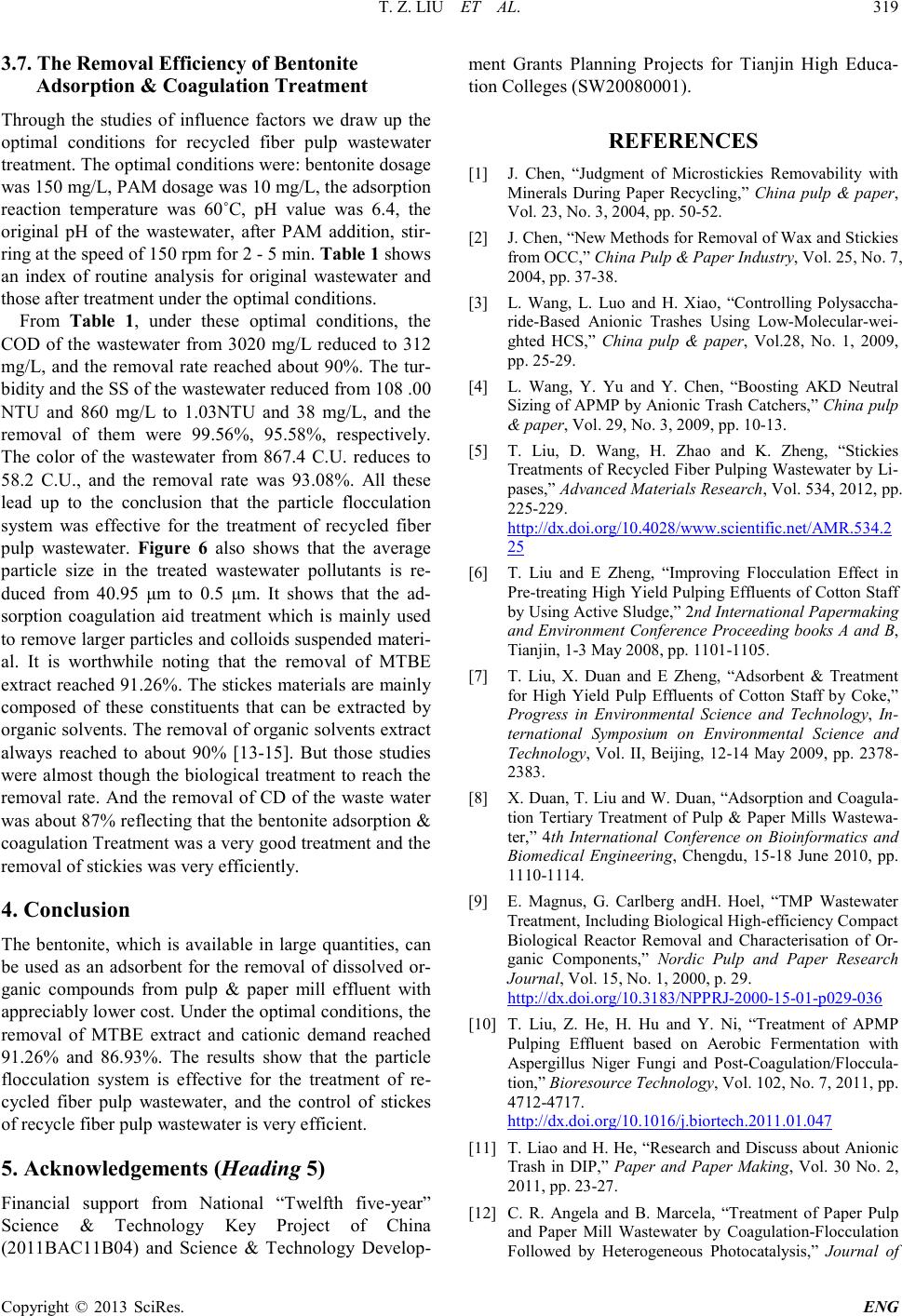
T. Z. LIU ET AL.
Copyright © 2013 SciRes. ENG
3.7. The Removal Efficiency of Bentonite
Adsorption & Coagulation Treatment
Through the studies of influence factors we draw up the
optimal conditions for recycled fiber pulp wastewater
treatment. The optimal co nditi ons were: bentonite dosage
was 150 mg/L, PAM dosage was 10 mg/L, the adsorption
reaction temperature was 60˚C, pH value was 6.4, the
original pH of the wastewater, after PAM additio n, stir-
ring at the speed of 150 rpm for 2 - 5 min. Table 1 shows
an index of routine analysis for original wastewater and
those after treatment under the optimal cond itions.
From Table 1, under these optimal conditions, the
COD of the wastewater from 3020 mg/L reduced to 312
mg/L, and the removal rate reached about 90%. The tur-
bidity and the SS of the waste water red uced from 108 .00
NTU and 860 mg/L to 1.03NTU and 38 mg/L, and the
removal of them were 99.56%, 95.58%, respectively.
The color of the wastewater from 867.4 C.U. reduces to
58.2 C.U., and the removal rate was 93.08%. All these
lead up to the conclusion that the particle flocculation
system was effective for the treatment of recycled fiber
pulp wastewater. Figure 6 also shows that the average
particle size in the treated wastewater pollutants is re-
duced from 40.95 μm to 0.5 μm. It shows that the ad-
sorption coagulation aid treatment which is mainly used
to remove larger particles and colloids suspended materi-
al. It is worthwhile noting that the removal of MTBE
extract reached 91.26%. The stickes materials are mainly
composed of these constituents that can be e xtracted by
orga nic so lve nts. T he removal of organi c sol vent s extract
always reached to about 90% [13-15]. But those studies
were almost though the biological treatment to reach the
removal rate. And the removal of CD of the waste water
was about 87% reflecting that the bento nite adsor ption &
coagulation T r eatment wa s a very good treatment and the
removal of stickies was very efficiently.
4. Conclusion
The bentonite, which is available in large quantities, can
be used as an adsorbent for the removal of dissolved or-
ganic compounds from pulp & paper mill effluent with
appreciably lower cost. Und er the optimal condition s, the
removal of MTBE extract and cationic demand reached
91.26% and 86.93%. The results show that the particle
flocculation system is effective for the treatment of re-
cycled fiber pulp wastewater, and the control of stickes
of recycle fiber pulp wastewater is very efficien t.
5. Acknowledgemen ts (Heading 5)
Financial support from National “Twelfth five-year”
Science & Technology Key Project of China
(2011BAC11B04) and Science & Technology Develop-
ment Grants Planning Projects for Tianjin High Educa-
tion Colleges (SW 20080001).
REFERENCES
[1] J. Chen, “Judgment of Microstickies Removability with
Minerals During Paper Recycling,” China pulp & paper,
Vol. 23, No. 3, 2004, pp. 50-52.
[2] J. Chen, “New Methods for Removal o f Wax and Stickies
from OCC,” China Pulp & Paper Industry, Vol. 25, No. 7,
2004, pp. 37-38.
[3] L. Wang, L. Luo and H. Xiao, “Controlling Pol ysaccha-
ride-Based Anionic Trashes Using Lo w-M olecular-wei-
ghted HCS,” China pulp & paper, Vol.28, No. 1, 2009,
pp. 25-29.
[4] L. Wang, Y. Yu and Y. Chen, “Boosting AKD Neutral
Sizing of APMP by Anionic Trash Catchers,” China pulp
& paper, Vol. 29, No. 3, 2009, pp. 10-13.
[5] T. Liu, D. Wang, H. Zhao and K. Zheng, “Stickies
Treatments of Recycled Fiber Pulping Wastewater by Li-
pases,” Ad vanced Mat erial s Research, Vo l. 534, 2012, p p.
225-229.
http://dx.doi.org/10.4028/www.scientific.net/AMR.534.2
25
[6] T. Liu and E Zheng, “Improving Flocculation Effect in
Pre-treating High Yield Pulping Effluents of Cotton Staff
by Using Active Sludge,” 2nd International Papermaking
and Environment Conference Proceeding books A and B,
Tianjin, 1-3 May 2008, pp. 1101-1105.
[7] T. Liu, X. Duan and E Zheng, “Adsorbent & Treatment
for High Yield Pulp Effluents of Cotton Staff by Coke,”
Progress in Environmental Science and Technology, In-
ternational Symposium on Environmental Science and
Technology, Vol. II, Beijing, 12-14 May 2009, pp. 2378-
2383.
[8] X . Dua n, T. Li u and W. Duan, “Adsorption and Coagula-
tion Tertiary Treatment of Pulp & Paper Mills Wastewa-
ter,” 4th International Conference on Bioinformatics and
Biomedical Engineering, Chengdu, 15-18 June 2010, pp.
1110-1114.
[9] E. Magnus, G. Carlberg andH. Hoel, “TMP Wastewater
Treatment , In clud ing Biol ogi cal High-efficien c y Co mpact
Biological Reactor Removal and Characterisation of Or-
ganic Components,” Nordic Pulp and Paper Research
Journal, Vol. 15, No. 1, 2000 , p. 29.
http://dx.doi.org/10.3183/NPPRJ-2000-15-01-p029-036
[10] T. Liu, Z. He, H. Hu and Y. Ni, “Treatment of APMP
Pulping Effluent based on Aerobic Fermentation with
Aspergillus Niger Fungi and Post-Coagulation/Floccula-
tion,” Bioresource Technology, Vol. 102, No. 7, 2011, pp.
4712-4717.
http://dx.doi.org/10.1016/j.biortech.2011.01.047
[11] T. Liao and H. He, “Research and Discuss about Anioni c
Trash in DIP,” Paper and Paper Making, Vo l . 30 No. 2,
2011, pp. 23-27.
[12] C. R. Angela and B. Marcela, “Treatment of Paper Pulp
and Paper Mill Wastewater by Coagulation-Flocculation
Followed by Heterogeneous Photocatalysis,” Journal of